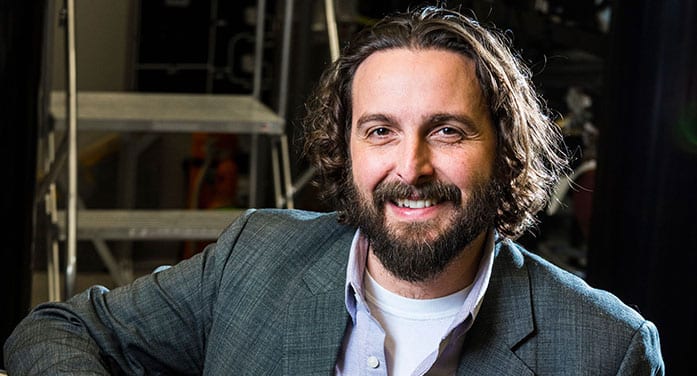
U of A physicist John P. Davis is co-lead on a project to add new and upgraded capacity for nano-fabrication in Alberta, with potential applications in quantum technology projected to be an $8.2-billion industry in Canada by 2030. (Photo: John Ulan; taken pre-COVID-19)
On Oct. 29, 1969, researchers at UCLA, with help from a computer the size of a cement truck, sent what would become the first message over the first incarnation of the “internet” to Stanford. The first two letters of the one-word message, LOGIN, made the cross-California trip before the fledgling system crashed.
“Fifty years ago when the internet was developed and they first started networking computers, no one thought it was going to be useful. No one could have predicted what we have now,” said John P. Davis, a physics professor in the University of Alberta’s Faculty of Science.
“We’re building a new technology. ‘If you build it they will come’ is the way we have to think about this.”
The technology Davis and his team are focused on building is the quantum internet, or at least a piece of it.
He explained what his team is building are quantum transducers, which take quantum information from one system to another.
“It’s basically like an interpreter from one system to another,” he said.
The Davis Lab in the Department of Physics works on superconductivity experiments at temperatures approaching absolute zero to find materials that one day could be made to work with zero electrical resistance at more practical temperatures.
And though the transmission of quantum information usually requires extreme cold, Davis said it turns out fibre optics might provide the quantum internet a home.
“What we’re trying to do is build something that allows these superconducting quantum processors to engage with these wavelengths that can be sent over fibre optics,” he said.
Davis said the advantages to a quantum internet are still unknown and possibly limitless. Currently, quantum-based cryptography is being pursued as one avenue of an “unhackable” internet, but other applications are sure to arise as the technology develops.
“Our goal is to build up the technology so that quantum computers can one day talk to each other,” he said. “Perhaps, everyday tasks that can be done by a classical computer now will eventually be done by a quantum computer.”
To help, the federal government, through the Canada Foundation for Innovation (CFI), has committed $5.2 million of a $13.1-million project to bolster the U of A’s nano-fabrication facility ($2 million) and create one at the University of Calgary. These centralized, open-access research and development facilities specialize in micro- and nanoscale fabrication and characterization. The co-lead on the grant, Paul Barclay out of Calgary, is looking at making tiny nanomechanical structures out of diamond.
“This CFI (funding) is buying the tools to build state-of-the-art materials that are far from standard, that need to be probed with laser systems, or be cooled down to very low temperatures,” he said.
He added, “These are the kinds of things that we do as researchers – playing with these new technologies that often, at least with my group, require very low temperatures where we can reveal these quantum properties.”
Davis explained the provincial government has invested $22 million since 2016, including $6.1 million from its Major Innovation Fund, in a pan-Albertan consortium called Quantum Alberta that includes more than 30 researchers across the U of A, U of C, University of Lethbridge, SAIT and NAIT.
The rationale for this quantum focus, according to Davis, is that while Canadian photonic companies already generate more than $4 billion a year in revenue and employ 25,000 Canadians, it is projected that by 2030, Canada will be able to grow an $8.2-billion quantum technology industry, employing 16,000 people.
“The overarching idea is quantum technologies for diversifying Alberta’s future,” he said.
Davis is also part of the Quanta program, an NSERC CREATE program designed to train industry-ready graduate students in emerging quantum technologies. Quanta graduates will be prepared to create and advance quantum technology companies, ensuring Canada’s central role in leading the quantum age.
All told, five U of A-led projects received $24.1 million in CFI funding, of which $19.3 million is coming to the U of A. The balance will go to project partner institutions across Canada. An additional eight projects led out of partner institutions secured $8.2 million in CFI funding for the U of A. Proposals for matching provincial funding for these projects are with the provinces pending results.
| By Michael Brown for Troy Media
This article was submitted by the University of Alberta’s Folio online magazine. Folio is a Troy Media![]() Editorial Content Provider Partner.
Editorial Content Provider Partner.

